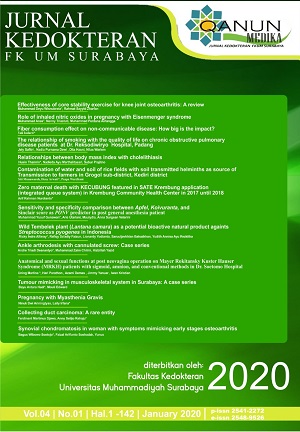Ankle Arthrodesis with Cannulated Screw: Case Series
Abstract
ABSTRACT
Ankle osteoarthritis patients are young and lack of available long last treatment. Ankle arthrodesis remains the gold standard and is the procedure of choice for younger patients who are heavy laborers. These case series evaluate and report five patients undergone ankle arthrodesis at RSUD Dr. Soetomo Surabaya on 2012-2016. The data were collected from patient files, radiographs, and a recent physical examination. The outcome has been assessed with SF-36 score and clinical scoring system Ankle-Hind foot American Foot and Ankle Society. Three male patients and two female patients underwent ankle arthrodesis with cannulated screw, caused by neglected severe ankle dislocation. One patient had open dislocation. Based on SF-36 scoring, the five patients had average score 76,7 with highest and lowest score were 95,9 and 56,7. Based on clinical score ankle-hind foot American Ankle and Foot Society, the average score was 68(51 – 88). The scoring result includes general health, physic, emotional, and social. And clinical scoring ankle-hind foot American Foot and Ankle Society evaluation includes pain, function, and alignment. It shows that there was patient that gains an almost perfect result. Patient with the lowest score also had knee osteoarthritis contralateral from the operated ankle. Early weight bearing on ankle arthrodesis with cannulated screw was the major factor caused unsatisfactory result of this patient. Ankle arthrodesis with cannulated screw has satisfactory result eventhough remain complain on one patient. Nevertheless, ankle arthrodesis with cannulated screw still has an important role in the treatment of choice on ankle reconstruction.
Keywords                  : Ankle arthrodesis, cannulated screw, ankle joint fusion
Â
Full text article
References
Abidi, NA. Gruen, GS. Conti, SF. (2000) Ankle Arthrodesis: Indications and Techniques. J Am Acad Orthop Surg; 8: 200-209
Alfahd, U. Roth, SE. Stephen, D. Whyne, CM. (2005) Biomechanical Comparison of Intramedullary Nail and Blade Plate Fixation for Tibiocalcaneal Arthrodesis. J Orthop Trauma; 19(10): 703-8
Alvarez, RG. Barbour, TM. Perkins, TD. (1994) Tibiocalcaneal Arthrodesis for Nonbraceable Neuropathic Ankle Deformity. Foot Ankle Int; 15: 354-59
Buck, P. Morrey, BF. Chao, EY. (1987) The Optimum Position of Arthrodesis of The Ankle: A Gait Study of The Knee and Ankle. J Bone Joint Surg Am; 69:1052-62
Cobb, TK. Gabrielsen, TA. Campbell, DC 2nd. Wallrichs, SL. Ilstrup, DM. (1994) Cigarette Smoking and Nonunion After Ankle Arthrodesis. Foot Ankle Int;15: 64-67
Domsic, RT. Saltzman, CL. (1998) Ankle Osteoarthritis Scale. Foot Ankle Int; 19: 466-71
Fuchs,S. Sandmann, C. Swakara, A. Chylarecki, C. (2003) Quality of Life 20 years after arthrodesis of the ankle. A study of adjacent joints. J Bone Joint Surg Br; 85(7):994-8
Garcia, S. Camacho, P. Segur, JM. Fernandez De Retana, P. Combalia, A. (2001) Stress Fracture of The Tibia After Ankle Arthrodesis: a Review of Three Cases. Foot and Ankle Surgery Vol 7: Issue 3, 175-180
Gruen, GS. Mears, DC. (1991) Arthrodesis of The Ankle and Subtalar Joints. Clin Orthop; 268: 15-20
Hendericson, A. Kamrad,I. Rosengren, B. Carlsson, A. (2016) Bilateral Arthrodesis of the Ankle Joint: Self Reported Outcomes in 35 Patients From the Swedish Ankle Registry. The Journal of Foot and Ankle Surgery 55: 1195-1198
Herrera-Perez,M. Andarica-Banuelos,C. et al. (2015) Comparison of Cannulated Screws Versus Compression Staples for Subtalar Arthrodesis Fixation. Foot and Ankle International Vil 36(2) 203-210.
Kakarala,G. Rajan, D. Comparative Study of Ankle Arthrodesis Using Cross Screw Fixation Versus Anterior Contoured Plate plus Cross Screw Fixation. Acta Orhtop 2006,72, 716-721.
Malarkey, RF. Binski, JC. (1991) Ankle Arthrodesis with the Calandruccio Frame and Bimalleolar Onlay Grafting. Clin Orthop; 268: 44-48
Mann, RA. (1982) Biomechanical Approach to The Treatment of Foot Problems. Foot Ankle; 2: 205-12
Mann, RA. Rongstad, KM. (1998) Arthrodesis of The Ankle: A Clinical Analysis. Foot Ankle Int; 19: 3-9
Myerson, MS. Quill, G. (1991) Ankle Arthrodesis: A Comparison of An Arthroscopic and An Open Method of Treatment. Clin Orthop; 268: 84-95
Paremain, GD. Miller, SD. Myerson, MS. (1996) Ankle Arthrodesis: Result After The Miniarthrotomy Technique. Foot Ankle Int; 17: 247-52
Pinzur, MS. Kelikian, A. (1997) Charcot Ankle Fusion with A Retrograde Locked Intramedullary Nail. Foot Ankle Int; 18: 699-704
Schuh, R. Hoffstaeter, J. Krismer, M. et al. (2012) Total Ankle Arthroplasy Versus Ankle Arhtrodesis, Comparison of Sports, Recreational Activities and Functional Outcome. International Orthopaedics (SCIOT) 36:1207-1214.
Tenenbaum, S. Coleman, SC. Brodsky, JW. (2014) Improvement in Gait Following Combined Ankle and Subtalar Arthrodesis. J Bone Joint Surg Am; 96:1863-9
Thevendran, G. Shah, K. Pinney, SJ. Younger, ASE. (2017) Perceived Risk Factors for Nonunion Following Foot and Ankle Arthrodesis. Journal of Orthopaedic Surgery; 25(1): 1-6
Thodarson, DB. Markolf, K. Cracchiolo, A 3rd. (1994) External Fixation in Arthrodesis of The Ankle: A Biomechanical Study Comparing A Unilateral Frame with A Modified Transfixtion Frame. J Bone Joint Surg Am; 76: 1541-44
Troullier, H. Hansel, L. Schaff, P. Rosemeyer, B. Refior, HJ. (2002) Long-Term Result After Ankle Arthrodesis: Clinical, Radiological, Gait Analytical Aspects. Foot and Ankle International; Vol: 23 Issue: 12; 1081-1090
Saltzman, CL. Mann, RA. Ahrens, JE. (2009) Prospective Controlled Trial of STAR Total Ankle Replacement versus Ankle Fusion: Initial Resuls. Foot Ankle Int; 30(7): 576-96
Weatherall, JM. Mroczek, K. McLaurin, T. Ding, B. Tejwani, N. (2013) Post-Traumatic Ankle Arthritis. Bulletin of the Hospital for Joint Disease; 71(1): 104-12
Authors

Qanun Medika by FK UM Surabaya is liscence under Lisensi Creative Commons Atribusi 4.0 Internasional.

